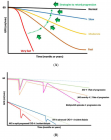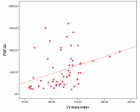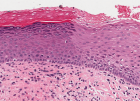Abstract
Research Article
Nematicidal effect of abamectin, boron, chitosan, hydrogen peroxide and Bacillus thuringiensis against citrus nematode on Valencia orang
Sherin FA Awd Allah*, Sandy E Hammad and MAM El-Saedy
Published: 12 December, 2019 | Volume 3 - Issue 3 | Pages: 111-117
The nematicidal efficacy of abamectin, boron, chitosan, hydrogen peroxide, Bacillus thuringiensis and oxamyl 24% SL against citrus nematode, Tylenchulus semipenetrans were examined on Valencia orange trees under field condition for two successive seasons (2017 and 2018). The experiment was conducted in a Valencia orange orchard infested with citrus nematode at Nubaria, El-Behera governorate, Egypt. The obtained results showed that all the tested treatments reduced nematode final population ((Pf) and reproduction factor (Rf) compared with that obtained from the untreated trees. The highest percentages of Pf reductions (74.5-83.4 %) and (70%-82%) were recorded with oxamyl, boron, abamectin, chitosan and H2O2 in the 1st and the 2nd tested seasons, respectively. Whereas, B. thuringiensis had the least nematode Pf reduction with 60.7 and 55.8% in the 1st and 2nd seasons, respectively. Additionally, all treatments significantly improved orange yield (30.9-83.2% increase), physical fruit parameters and orange juice properties. The highest orange yield increase (83.2%) was recorded with boron treatment followed by oxamyl (70.3%). Also, boron increased total soluble solids (TSS) by 13.6%, volume of orange juice (36.4%) and vitamin C (19.7%) and decreased juice acidity (A) by (16.7%). It is concluded that abamectin, boron and the other tested compounds have potential as non-chemical control strategy tools in managing the citrus nematode. These bioagents reduced the amount of traditional chemical nematicides and are considered to be environmentally safe.
Read Full Article HTML DOI: 10.29328/journal.jpsp.1001041 Cite this Article Read Full Article PDF
Keywords:
Biocontrol; Oxamyl; Tylenchulus semipenetrans; Vydate® L; Yield; Fruit properties
References
- Omar Shaza, Tate B. Egypt, Egyptian orange Exports continue to expand. USDA Foreign Agricultural Service, Global Agricultural Information Network, Gain Report Number: EG 18031. 2018; 10.
- Ahmad MS, Mukhtar T, Ahmad R. Some studies on the control of citrus nematode (Tylenchulus semipenetrans) by extracts of three plants and their effects on plant growth variables. Asian J Plant Sciences. 2004; 3: 544-548.
- Verdejo-Lucas S, Mc Kenry MV. Management of the citrus nematode, Tylenchulus semipenetrans. J Nematol. 2004; 36: 424-432. PubMed: https://www.ncbi.nlm.nih.gov/pubmed/19262822
- Sorribas FJ, Verdejo-Lucas S, Pastor J, Ornat C, Pons J, et al. Population densities of Tylenchulus semipenetrans related to physicochemical properties of soil and yield of Clementine mandarin in Spain. Plant Dis. 2008; 92: 445-450. PubMed: https://www.ncbi.nlm.nih.gov/pubmed/30769676
- Abd-Elgawad MM, Duncan LW, Koura FHF, Abd El-Wahab AE, Montasser SA, et al. Management revision and observations on Tylenchulus semipenetrans on citrus yield in Egypt. Egypt Journal of Agronematol. 2011; 10: 64-77.
- El-Tanany MM, El-Shahaat MS, Khalil MS. Efficacy of three bio-pesticides and oxamyl against citrus nematode (Tylenchulus semipenetrans) and on productivity of Washington navel orange trees. Egyptian Journal of Horticulture. 2018; 45: 275-287.
- Pitterna T, Cassayre J, HـTER OF, Jung PM, Maienfisch P, et al. New ventures in the chemistry of avermectins. Bioorg Med Chem. 2009; 17: 4085-4095. PubMed: https://www.ncbi.nlm.nih.gov/pubmed/19168364
- Saad ASA, Massoud MA, Ibrahim HS, Khalil MS. Activity of nemathorin, natural product and bioproducts against root-knot nematodes on tomatoes. Arch Phytopathol Plant Prot. 2012; 45: 955-962.
- Khalil MS. Abamectin and azadirachtin as eco-friendly promising biorational tools in integrated nematodes management programs. J Plant Pathology Microb. 2013; 4: 174.
- Saad ASA, Radwan MA, Mesbah HA, Ibrahim HS, Khalil MS. Evaluation of some non-fumigant nematicides and the biocide avermectin for managing Meloidogyne incognita in tomatoes. Pakistan Journal of Nematology. 2017; 35: 85-92.
- El-Nagdi WMA. Studies on banana nematodes in Egypt. Ph.D. Thesis, Faculty of Agriculture, Cairo University, Cairo, Egypt. 2001; 178.
- Youssef MMA, El-Nagdi WMA, Kassim FSE, El-Kholy LAF, Saleh MMS. Nematicidal and horticultural evaluation of sea ambrosia (Ambrosia maritima) plant and abamectin on banana infested by Meloidogyne incognita. Egyptian Journal of Agriculture Research NRC. 2005; 2: 411-429.
- Radwan MA, Saad ASA, Mesbah HA, Ibrahim HS, Khalil MS. Investigating the in vitro and in vivo nematicidal performance of structurally related macrolides against the root-knot nematode, Meloidogyne incognita. Hellenic Plant Protection Journal. 2019; 12: 24-37.
- Intikhab AJ, Shabir HW, Bhatt MA, Hussain A, Raja W, et al. Micronutrients for Crop Production: Role of Boron. Int J Current Microbiology Applied Sciences. 2017; 6: 5347-5353.
- Preethi M, Prakash DP, Kulapati Hipparagi IB, Biradar SG, Gollagi, et al. Effect of Quantity of Soil Application of Zinc, Boron and Iron on Growth and Yield in Papaya cv. Red Lady. Int J Curr Microbiol App Sci. 2017; 6: 2081-2086.
- El-Nagdi WM, Youssef MM. Effect of certain medicinal plant extracts, a bioicde and a biofertilizer for controlling Meloidogyne incognita infesting grapevines in Egypt. International Journal of Nematology. 2009; 19: 40-46.
- El-Saedy MAM, El-Sayed MEA, Hammad SE. Efficacy of boron, silicon, jojoba and four bio-products on controlling Meloidogyne incognita infecting Thompson seedless grapevines. American-Eurasian Journal of Agriculture & Environmental Sciences. 2015; 15: 1710-1720.
- Mack I, Hector A, Ballbach M, Kohlhaufl J, Fuchs KJ, et al. The role of chitin, chitinases, and chitinase-like proteins in pediatric lung diseases. Mol Cell Pediatr. 2015; 2: 3. PubMed: https://www.ncbi.nlm.nih.gov/pubmed/26542293
- Hassan O, Chang T. Chitosan for eco-friendly control of plant disease. Asian Journal of Plant Pathology. 2017; 11: 53-70.
- Aboud HM, Fattah FA, Al-Heeti AA, Saleh HM. Efficiency of chitosan in inducing systemic acquired resistance against the root-knot nematode (Meloidogyne javanica (Treub) (Chitwood) on tomato. Arab Journal of Plant Protection. 2002; 20: 93–98.
- Khalil MS, Badawy MEI. Nematicidal activity of a biopolymer chitosan at different molecular weights against root-knot nematode, Meloidogyne incognita. Plant Protection Science. 2012; 48: 170-178.
- El-Sayed SM, Mahdy ME. Effect of chitosan on root-knot nematode, Meloidogyne javanica on tomato plants. Int J Chem Tech Res. 2015; 7: 1985-1992.
- Ibrahim, Dina SS, Nour El-Deen AH, Khalil AE, Fatma AMM. Induction of systemic resistance in sugar-beet infected with Meloidogyne incognita by humic acid, hydrogen peroxide, thiamine and two amino acids. Egypt J Agronematol. 2013; 12: 22-41.
- Hammad Sandy EI. Isolation and identification of Bacillus thuringiensis toxins and their role in controlling root-knot nematode on eggplants. Ph.D. Thesis. Faculty of Agriculture, El-Shateby, Alexandria University Egypt. 2005; 116.
- El-Nagdi WMA, Yossef MMA, Hafez OM. Effects of commercial formulations of Bacillus thuringiensis and Streptomyces avermitilis on Tylenchulus semipenetrans and on nutrition status, yield and fruit quality of mandarin. Nematologia Mediterrania. 2010; 38: 147-157.
- Hammam MMA, El-Nagdi WM, Abd-Elgawad MMM. Biological and chemical control of the citrus nematode, Tylenchulus semipenetrans (Cobb, 1913) on mandarin in Egypt. Egyptian Journal of Biological Pest Control. 2016; 26: 345-349.
- Khalil MS, Abd El-Naby SSI. The integration efficacy of formulated abamectin, Bacillus thuringiensis and Bacillus subtilis for managing Meloidogyne incognita (Kofoid and White) Chitwood on tomatoes. J Biopesticides. 2018; 11: 146-153.
- Barker KR. Sampling nematode communities. In: An advanced treatise on Meloidogyne, Vol. II, Methodology, Barker, K. R., Carter, C. C. & Sasser, J. N. (Ed.), Graphics, North Carolina State University Raleigh, USA. 1985; 3-17.
- Ayoub SM. Plant nematology, an agricultural training aid. Secramanto, California, USA, Nema aid Publications. 1980; 195.
- Southey JF. Laboratory methods for work with plant and soil nematodes. Tech Bull Ministry of Agriculture, Fishers and Food, London. 1970; 176.
- Oostenbrink M. Major characteristics of the relation between nematodes and plants. Mededelingen van Landlouwhogesch, Wageningen, The Netherlands. 1966; 46.
- Mulla MS, Norland L, Fanara DM, Darwazeh HA, McKean DW. Control of Chironomid midges in recreational lakes. J Economic Entomology. 1971; 64: 300-307.
- O.A.C. Official methods of analysis of the Association of Official Analytical Chemists. 16th Ed., AOAC International, Washington DC, USA. 1995; 490-510.
- SAS Institute. SAS/STAT User's Guide. Release 6.03 Edition-6th edition. SAS Institute Inc., North Carolina, Cary. Inc 27512-8000. 1997; 1028.
- Khalil AE, Nour El-Deen AH, Mahmoud NA. Evaluate the effectiveness of various nematicides and bio-agents in controlling nematode diseases on certain fruit crops under Ismailia governorate conditions in Egypt. Egypt. J Agronematology. 2012a ; 11: 320-332.
- El-Nagdi WMA, Hafez OM, Saleh MA. Impact of a biocide abamectin for controlling of plant parasitic nematodes, productivity and fruit quality of some date palm cultivars. Science of Agriculture. 2015; 11: 20-25.
- Martin RJ, Robertson AP, Wolstenholme AJ. Mode of action of the macrocyclic lactones. In: Vercruysse J, Rew RS (Eds) Macrocyclic lactones in antiparasitic therapy. United Kingdom, Wallingford. 2002; 125–162.
- Huang WK, Sun JH, Cui JK, Wang GF, Kong LA, et al. Efficacy evaluation of fungus Syncephalastrum racemosum and nematicide avermectin against the root-knot nematode Meloidogyne incognita on cucumber. PLoS One. 2014; 9: e89717. PubMed: https://www.ncbi.nlm.nih.gov/pubmed/24586982
- Muzhandu RT, Chinheya CC, Dimbi S, Manjeru P. Efficacy of abamectin for the control of root-knot nematodes in tobacco seedling production in Zimbabwe. African Journal of Agricultural Research. 2014; 9: 144-147.
- Lopez-Perez JA, Edwards S, Ploeg A. Control of root-knot nematodes on tomato in stone wool substrate with biological nematicides. J Nematol. 2011; 43: 110-117. PubMed: https://www.ncbi.nlm.nih.gov/pubmed/22791920
- Kotze AC, Grady O, Gough J, Pearson JM, Bagnall R, Kemp DH, et al. Toxicity of Bacillus thuringiensis to parasitic and free-living life stages of nematodes parasites of livestock. Int J Parasitol. 2005; 35: 1013-1022. PubMed: https://www.ncbi.nlm.nih.gov/pubmed/15964574
- Iatsenko I, Boichenko I, Sommer RJ. Bacillus thuringiensis DB27 produces two novel protoxins, Cry21Fa1 and Cry21Ha1, which act synergistically against nematodes. Appl Environ Microbiol. 2014; 80: 3266-3275. PubMed: https://www.ncbi.nlm.nih.gov/pubmed/24632254
- Awd-Allah SFA, El-Sherbiny AA. Non-chemical control of Heterodera golden and Meloidogyne incognitaon rice plants using residues of Oyster mushroom cultivation and supernatant of Bacillus thuringiensis before transplanting under field microplot conditions. Egyptian J Agronematology. 2015; 14: 62-77.
- Gustin EJ, McDonnell GE, Mullen G, Gordon BE. The efficacy of vapor phase hydrogen peroxide against nematode infestation of the Caenohabditis elegans model. 27–31 October 2002, 53rd AALAS National Meeting, San Antonio, Texas, USA. 2002.
- Jansen WT, Bolm M, Balling R, Chhatwal GS, Schnabel R. Hydrogen peroxide-mediated killing of Caenorhabditis elegans by Streptococcus pyogenes. Infect Immun. 2002; 70: 5202–5207. PubMed: https://www.ncbi.nlm.nih.gov/pubmed/12183571
- Bolm M, Wouter T, Jansen M, Schnabel R, Chatwal GS. Hydrogen peroxide-mediated killing of Caenorhabditis elegans: a common feature of different Streptococcal species. Infect Immun. 2004; 72: 1192–1194. PubMed: https://www.ncbi.nlm.nih.gov/pubmed/14742574
- Desikan R, Soheila A, Mackerness H, Hancock JT, Neill SJ. Regulation of the Arabidopsis transcriptome by oxidative stress. Plant Physiol. 2001; 127: 159–172. PubMed: https://www.ncbi.nlm.nih.gov/pubmed/11553744
- Lopez-Huertas E, Charlton WL, Johnson B, Graham IA, Baker A. Stress induces peroxisome biogenesis genes. EMBO J. 2000; 19: 6770–6777. PubMed: https://www.ncbi.nlm.nih.gov/pubmed/11118212
- Jaiti F, Dihazi A, El-Hadrami A, El-Hassni M, El-Hadrami I. Effect of exogenous application of jasmonic acid on date plam defense reaction agnst Fusarium oxysporum f. sp. albedinis. Phytopathologia Mediterranea. 2004; 43: 325–331.
- D’Errico G, Marra R, Vinale F, Landi S, Roversi PF, et al. Nematicidal efficacy of new abamectin-based products used alone and in combination with indole butyric acid against the root-knot nematode Meloidogyne incognita. J Zoology. 2017; 100: 95-101.
- Radwan MA. Bioactivity of commercial products of Bacillus thuringiensis on Meloidogyne incognita infecting tomato. Ind J Nematol. 2007; 37: 30-33.
- Ibrahim HS, Saad ASA, Massoud MA, Khalil MSH. Evaluation of certainagrochemicals and biological agents against Meloidogyne incognita on tomatoes. Alexandria Science Exchange Journal. 2010; 31: 10-17.
- Khan MQ, Abbasi MW, Zaki MJ, Khan SA. Evaluation of Bacillus thuringiensis isolates against root-knot nematodes following seed application in okra and mungbean. Pakistan J Botany. 2010; 42: 2903-2910.
- Khalil MSH, Allam AFG, Barakat AST. Nematicidal activity of some biopesticide agents and microorganisms against root-knot nematode on tomato plants under greenhouse conditions. J Plant Protection Research. 2012b; 52: 47-52.
- Ferraz S, Freitas LG, Lopes EA, Dias-Arieira CR. Manejo sustentável de fitonematoides. Viçosa: Editora UFV. 2010; 306.
- Santana-Gomes SM, Dias-Arieira CR, Roldi M, Dadazio TS, Marini PM, et al. Mineral nutrition in the control of nematodes. African Journal of Agricultural Research. 2013; 8: 2413-2420.
- Abd-Allah AS. Effect of spraying some macro and micro nutrients on fruit set, yield and fruit quality of Washington Navel orange trees. J Appl Sci Res. 2006; 2: 1059-1063.
- Edward Raja M. Importance of micronutrients in the changing horticultural scenario in India. J Horticulture Science. 2009; 4: 1-27.
- Chibu H, Shibayama H. Effects of chitosan applications on the growth of several crops. In: Uragami T., Kurita K., Fukamizo T. (eds.): Chitin and Chitosan in Life Science. Proceedings 8th International Chitin and Chitosan Conference, Yamaguchi, September 2000, Kodansha Scientific Ltd., Tokyo. 2001; 235–239.
- No HK, Lee KS, Kim ID, Park MJ, Kim SD, et al. Chitosan treatment affects yield, ascorbic acid content, and hardness of soybean sprouts. J Food Sci. 2003; 68: 680–685.
- Nge KL, New N, Chandrkrachang S, Stevens WF. Chitosan as a growth stimulator in orchid tissue culture. Plant Science. 2006; 170: 1185–1190.
Similar Articles
-
Use of essential oils as new food preservatives (Case: Eucalyptus grandis and Eucalyptus crebra)Sendanyoye Marcel*. Use of essential oils as new food preservatives (Case: Eucalyptus grandis and Eucalyptus crebra). . 2018 doi: 10.29328/journal.jpsp.1001023; 2: 083-090
-
Isolation and biochemical characterization of Plant Growth Promoting (PGP) bacteria colonizing the rhizosphere of Tef crop during the seedling stageZerihun Tsegaye*,Birhanu Gizaw,Genene Tefera,Adey Feleke,Solomon Chaniyalew,Tesfaye Alemu,Fasil Assefa . Isolation and biochemical characterization of Plant Growth Promoting (PGP) bacteria colonizing the rhizosphere of Tef crop during the seedling stage. . 2019 doi: 10.29328/journal.jpsp.1001027; 3: 013-027
-
Non-chemical control of Armillaria mellea infection of Prunus persicaJim Downer*,Ben Faber. Non-chemical control of Armillaria mellea infection of Prunus persica. . 2019 doi: 10.29328/journal.jpsp.1001031; 3: 050-055
-
Avermectins: The promising solution to control plant parasitic nematodesMohamed S Khalil*,Dalia M Darwesh. Avermectins: The promising solution to control plant parasitic nematodes. . 2019 doi: 10.29328/journal.jpsp.1001036; 3: 081-085
-
Nematicidal effect of abamectin, boron, chitosan, hydrogen peroxide and Bacillus thuringiensis against citrus nematode on Valencia orangSherin FA Awd Allah*,Sandy E Hammad,MAM El-Saedy. Nematicidal effect of abamectin, boron, chitosan, hydrogen peroxide and Bacillus thuringiensis against citrus nematode on Valencia orang. . 2019 doi: 10.29328/journal.jpsp.1001041; 3: 111-117
-
Potential of Pleurotus sajor-caju compost for controlling Meloidogyne incognita and improve nutritional status of tomato plantsSherin FA Awd Allah*,Doaa M Mostafa,Eman FA Awad-Allah. Potential of Pleurotus sajor-caju compost for controlling Meloidogyne incognita and improve nutritional status of tomato plants. . 2019 doi: 10.29328/journal.jpsp.1001042; 3: 118-127
-
Natural infection of squash fruits (Cucurbita pepo) by Zucchini Yellow Mosaic potyvirus (ZYMV) in Alexandria governorateMahmoud Hamdy Abd El-Aziz*. Natural infection of squash fruits (Cucurbita pepo) by Zucchini Yellow Mosaic potyvirus (ZYMV) in Alexandria governorate. . 2020 doi: 10.29328/journal.jpsp.1001047; 4: 028-032
-
An experimental study on effects of fluoridated water on Abelmoschus esculentus var. Soh-198 (Lady Finger) Arshi Iram*Arshi Iram*. An experimental study on effects of fluoridated water on Abelmoschus esculentus var. Soh-198 (Lady Finger) Arshi Iram* . . 2021 doi: 10.29328/journal.jpsp.1001056; 5: 017-019
-
Silicon rates and beneficial microorganism on blast suppression and productivity of upland riceAlan Carlos Alves de Souza*,Eduardo Alves,Marta Cristina Corsi de Filippi,Adriano Stephan Nascente,Anne Sitarama Prabhu. Silicon rates and beneficial microorganism on blast suppression and productivity of upland rice. . 2021 doi: 10.29328/journal.jpsp.1001057; 5: 020-027
-
Ion transporters and their molecular regulation mechanism in plantsFaiçal Brini*,Walid Saibi. Ion transporters and their molecular regulation mechanism in plants. . 2021 doi: 10.29328/journal.jpsp.1001058; 5: 028-043
Recently Viewed
-
Sinonasal Myxoma Extending into the Orbit in a 4-Year Old: A Case PresentationJulian A Purrinos*, Ramzi Younis. Sinonasal Myxoma Extending into the Orbit in a 4-Year Old: A Case Presentation. Arch Case Rep. 2024: doi: 10.29328/journal.acr.1001099; 8: 075-077
-
High-Performance Liquid Chromatography (HPLC): A reviewAbdu Hussen Ali*. High-Performance Liquid Chromatography (HPLC): A review. Ann Adv Chem. 2022: doi: 10.29328/journal.aac.1001026; 6: 010-020
-
Drug Rehabilitation Centre-based Survey on Drug Dependence in District Shimla Himachal PradeshKanishka Saini,Palak Sharma,Bhawna Sharma*,Atul Kumar Dubey,Muskan Bhatnoo,Prajkta Thakur,Vanshika Chandel,Ritika Sinha. Drug Rehabilitation Centre-based Survey on Drug Dependence in District Shimla Himachal Pradesh. J Addict Ther Res. 2025: doi: 10.29328/journal.jatr.1001032; 9: 001-006
-
Poly-dopamine-Beta-Cyclodextrin Modified Glassy Carbon Electrode as a Sensor for the Voltammetric Detection of L-Tryptophan at Physiological pHMohammad Hasanzadeh*,Nasrin Shadjou,Sattar Sadeghi,Ahad Mokhtarzadeh,Ayub karimzadeh. Poly-dopamine-Beta-Cyclodextrin Modified Glassy Carbon Electrode as a Sensor for the Voltammetric Detection of L-Tryptophan at Physiological pH . J Forensic Sci Res. 2017: doi: 10.29328/journal.jfsr.1001001; 1: 001-009
-
WMW: A Secure, Web based Middleware for C4I Interoperable ApplicationsNida Zeeshan*. WMW: A Secure, Web based Middleware for C4I Interoperable Applications. J Forensic Sci Res. 2017: doi: 10.29328/journal.jfsr.1001002; 1: 010-017
Most Viewed
-
Evaluation of Biostimulants Based on Recovered Protein Hydrolysates from Animal By-products as Plant Growth EnhancersH Pérez-Aguilar*, M Lacruz-Asaro, F Arán-Ais. Evaluation of Biostimulants Based on Recovered Protein Hydrolysates from Animal By-products as Plant Growth Enhancers. J Plant Sci Phytopathol. 2023 doi: 10.29328/journal.jpsp.1001104; 7: 042-047
-
Sinonasal Myxoma Extending into the Orbit in a 4-Year Old: A Case PresentationJulian A Purrinos*, Ramzi Younis. Sinonasal Myxoma Extending into the Orbit in a 4-Year Old: A Case Presentation. Arch Case Rep. 2024 doi: 10.29328/journal.acr.1001099; 8: 075-077
-
Feasibility study of magnetic sensing for detecting single-neuron action potentialsDenis Tonini,Kai Wu,Renata Saha,Jian-Ping Wang*. Feasibility study of magnetic sensing for detecting single-neuron action potentials. Ann Biomed Sci Eng. 2022 doi: 10.29328/journal.abse.1001018; 6: 019-029
-
Pediatric Dysgerminoma: Unveiling a Rare Ovarian TumorFaten Limaiem*, Khalil Saffar, Ahmed Halouani. Pediatric Dysgerminoma: Unveiling a Rare Ovarian Tumor. Arch Case Rep. 2024 doi: 10.29328/journal.acr.1001087; 8: 010-013
-
Physical activity can change the physiological and psychological circumstances during COVID-19 pandemic: A narrative reviewKhashayar Maroufi*. Physical activity can change the physiological and psychological circumstances during COVID-19 pandemic: A narrative review. J Sports Med Ther. 2021 doi: 10.29328/journal.jsmt.1001051; 6: 001-007

HSPI: We're glad you're here. Please click "create a new Query" if you are a new visitor to our website and need further information from us.
If you are already a member of our network and need to keep track of any developments regarding a question you have already submitted, click "take me to my Query."

















































































































































